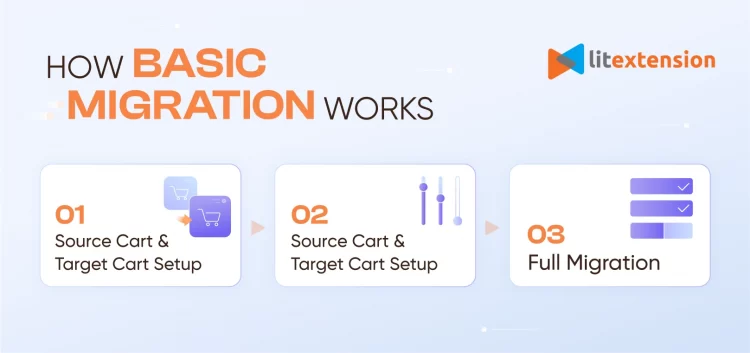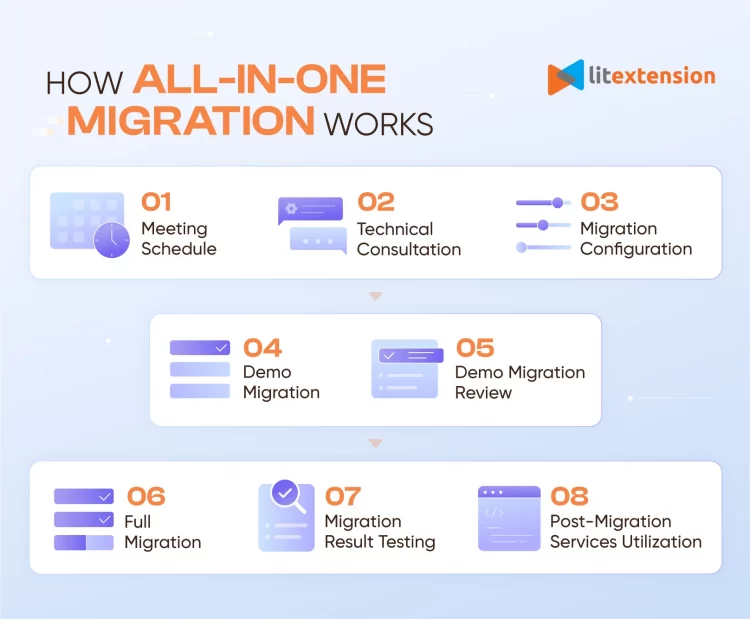Are you considering moving your online store to a new platform? Before executing an eCommerce migration, taking the proper preparation steps is key.
This article will walk you through everything you need to do to lay the groundwork for a smooth transition:
- Understanding eCommerce migration
- Reasons for an eCommerce platforming
- Benefits & Challenges when performing an eCommerce migration
- eCommerce re-platforming checklist
- 3 main methods for platform migrations
- Guide for an eCommerce migration
Let’s get started!
What is eCommerce Migration?
Ecommerce migration refers to the process of moving an online store from one platform or system to another. It’s the best practice to stay on top of digital shopping.
However, risks to websites are inevitable when it comes to re-platforming. They can be decreases in site speed, lacks of essential features, or even limited functionalities. Therefore, you surely need to look at the most effective methods, suitable times to migrate, and post-migration issues.
Need Help to Migrate Your Store?
If you intend to perform an eCommerce platform migration, LitExtension offers a great migration service that helps you transfer your data from the current eCommerce platform to a new one accurately, painlessly with utmost security.
Why Should You Perform eCommerce Migration?
#1 – You address store performance issues
Shopping cart migration is a way to increase the functionality that makes customers enjoy the experience in your store. In most cases, the goal is to improve the performance, capability, or usability of your business. Whenever you re-platform, you should make an evaluation of your current system, which can be any integrations and gaps between two websites.
We’ve been in the eCommerce industry for over ten years, and here’s what our customers said when deciding to perform cart-to-cart migration. And if you meet those issues, it’s a sign to move to another platform.
[wptb id=44853]
#2 – You face scalability issues
As your business grows, your current eCommerce platform may reach limitations in areas like user volumes, catalog size, order volumes etc. Migrating to a new platform ensures better scalability to support future growth as you expand operations.
Choosing the right target eCommerce solution will make a great impact on your business’s profitability and stability. Let’s roll back to the main types of platforms – open-source and hosted platforms:
[wptb id=44856]
You can either choose open-source or hosted shopping carts to grow your online business, depending on your future needs.
#3 – You find it’s the perfect time to perform eCommerce migration
As you’re facing performance and scalability issues, it’s high time for an eCommerce migration. The perfect time for the migration not to affect your customer’s experience and website traffic in any way.
Based on our years of experience, it will be better to transfer data when your site receives the lowest number of visitors. This period of time ensures that the migration will have the least negative impact on your business’s conversion and revenue.
Or else, you can turn on maintenance mode to ensure no interruption while migrating your data. However, you cannot receive any new orders (so that’s why you should find a method for a no-downtime migration process on your store!).
Carefully, you had better review your business reports to have final words on the best time to perform the migration!
eCommerce Replatforming Checklist to a Successful Migration
Whether you’re a merchant considering a platform change or an agency planning a client’s migration, proper project setup is key to a successful eCommerce replatform. Our checklist outlines all the essential stages to consider!
[wptb id=66452]
We believe that when you thoroughly execute this eCommerce migration checklist, you can set your business up for long-term success on the new platform!
Benefits & Challenges When Perform an eCommerce Migration
Replatforming is a significant undertaking for any eCommerce business. While it offers opportunities for business development, the process also presents challenges that could impact operations if not appropriately addressed.
As experts in eCommerce migrations, we have helped numerous clients smoothly transition their platforms over 12+ years. Through this experience, we have seen both the potential benefits of upgrading and the risks that often cause confusion and concern for merchants.
An honest portrayal of our clients’ true experiences leaves no room for surprises down the road!
#1 – Benefits of eCommerce migration
Here are some key benefits you may get when performing platform migration:
- Accessing new features can help attract more customers. For example, richer product options or improved search/browse capabilities.
- Performance improvements directly enhance the user experience. For example, faster loads and response times lead to increased conversion rates.
- Migrating to a robust platform version avoids security vulnerabilities. For example, keeping systems updated also enables future integrations.
- Technical issues like legacy code bugs and inflexible architectures will be resolved.
#2 – Challenges of eCommerce migration
Below are some common risks that should be considered during an eCommerce re-platforming:
- Downtime disrupts the customer experience and sales.
- Missing or corrupted data records impact inventory.
- Custom code extensions may need to be rewritten for new APIs. For merchants with limited in-house development resources, this can cause migration schedules to extend longer than expected.
- Staff and customers may take time to get on well with the new eCommerce store.
- Over-budgeting for migration projects may happen.
So, we’ve gone through all the benefits and challenges that eCommerce platform migrations can bring. With all that, we want merchants to feel confident moving forward by knowing both sides—the advantages that motivated the change alongside the challenges our expertise can help prevent.
Next, let’s explore some methods for eCommerce site migration.
3 Main Methods to Perform an eCommerce Migration
#1 – Perform manually
Basically, manual migration process involves exporting CSV files from your current cart and importing them to your new target one. However, you can lose the data when exporting databases into CSV files, and entities may be in the wrong folder after importing.
Therefore, it is important to compare the CSV file structures and make necessary changes before importing them to the target site. This action is to ensure data compatibility and exact location.
However, manual migration is mainly applicable to small businesses that have a limited number of data.
Naturally, if you have coding abilities and technological skills, you can run the eCommerce migration yourself. With this method, all your data is well-secured on your own, and you do not need to pay money for your migration.
To conclude, manual migration will be an ideal option if you are tech-savvy and have a limited amount of entities. Keep that in mind because, in some cases, you may not be able to export your data into CSV files due to incompatibility.
Who is this for: store owners with tech-savvy hands and a small number of entities.
#2 – Hire a digital agency or freelancer
If your business switch contains a large amount of data that needs a smoother transfer, you can hire a digital agency or freelance developer. However, you will spend a lot of money on eCommerce migration with a developer. Hiring a freelance developer can cost about $40 – $100 per hour.
Besides, keep in mind that there is a high chance your developer doesn’t completely understand the data structure of both platforms. You will encounter unexpected errors at any time. Accordingly, you may need more than one developer to get the job done.
As a result, the more time a developer spends, the more you have to pay. Therefore, while hiring either option may seem desirable to outsource the work, the migration process inherently carries substantial downsides around budget overruns and potential disruption to operations.
Instead, alternative solutions should be carefully explored, like choosing a data migration service.
Who is this for: store with larger databases.
#3 – Choose a data migration service
When it comes to eCommerce data migration, hiring a professional service with expert experience and knowledge is highly preferred.
Ecommerce migration services, like us, LitExtension, are specialists with extensive experience migrating between eCommerce platforms. They understand the nuanced data structures, formats, and types that power each platform’s functionality. Moreover, they have undertaken hundreds of migrations and intimately understand how different platforms organize things like products, customers, orders, etc.
Because data migration is their focus service, the running cost will be lower than digital agencies with broader capabilities. Streamlined processes and tools developed over time further increase efficiency at each stage, from assessment to execution. Without surprise overages, users receive predictable budgets that come in under initial freelancer estimates.
Who is this for: Everyone, from stores with small inventory to big enterprises.
How to Perform an eCommerce Migration with LitExtension
We, LitExtension, are the world’s leading shopping cart migration providers. With 12+ years of experience, we guarantee to satisfy all customers’ needs to perform the migration quickly, securely, and accurately.
#1 – Basic Migration
Our Basic Migration involves 3 simple steps that empower customers to take control of their migration workflow.

Here’s a brief explanation of our Basic migration:
- Customers will set up the Source Cart and Target Cart.
- They configure the migration by selecting which specific entities they wish to migrate such as products, categories, customers and orders.
- The full migration will run with just one click to transfer all the selected and mapped data between platforms automatically.
[wptb id=66456]
#2 – All-in-One Migration
LitExtension’s All-in-One Migration Package aims to minimize the time and effort spent on migrations. With it, you can benefit from having your entire project managed by a dedicated Personal Assistant.

Our Personal Assistant provides regular updates throughout the process. They work closely with you to refine store settings and ensure data migration quality. This results in a customized, white-glove service focused on client success.
[wptb id=66457]
Don’t Have Time for Migration Complexities?
Focus on growing your business and leave your eCommerce migration in good hands with LitExtension All-in-One Migration Package. Let our Personal Assistant lift the weight of manual tasks off your shoulder and provide regular updates on how your project is going.
eCommerce Migration Case Study
Ecommerce platform migrations represent a major strategic decision for any business. With significant implications, we understand that you may question whether transitioning is worth the effort.
At LitExtension, we understand the importance of making an informed choice. That’s why we want to share our clients’ real retail website migration case study and outcome with you.
Whether you’re still weighing options or want reassurance in your plans, we invite you to explore one of our success stories:
Rather than just promoting our service, this story is an honest look at what others in your position have truly encountered.
By learning from those who came before, you can make the most well-informed choice for your business and customers and their evolving needs. Our ultimate aim is to provide the insights, expertise, and guidance for your successful journey ahead.
Possible eCommerce Migration Concerns – FAQs
[sp_easyaccordion id=”44837″]
Final Words
To sum up, when your current platform doesn’t support you in sales performance, re-platforming your eCommerce website plays a substantial role in your work. However, e-Commerce migration will be only valuable when it can bring a certain improvement to your business operation and output.
Trust LitExtension to give you a safe, secure checkout experience so that you can focus on what you do best which is to develop a great product for your own customers. LitExtension team is available 24/7 to help you in all cases, and you just need to contact us!
Don’t forget that you can always check out eCommerce migration tips, selling tips, and any related eCommerce stuff via LitExtension Blog. For further exchange information, we do have Facebook Community for you to check out.